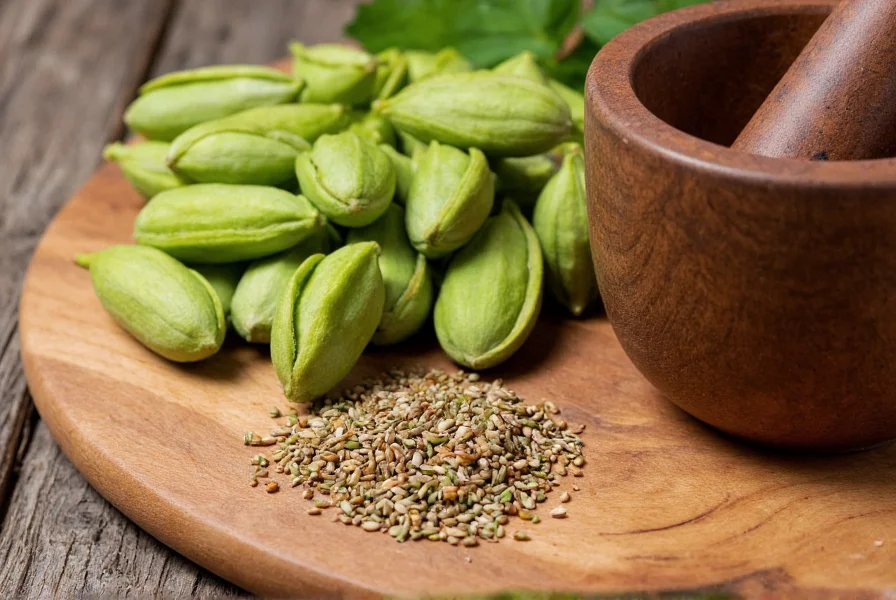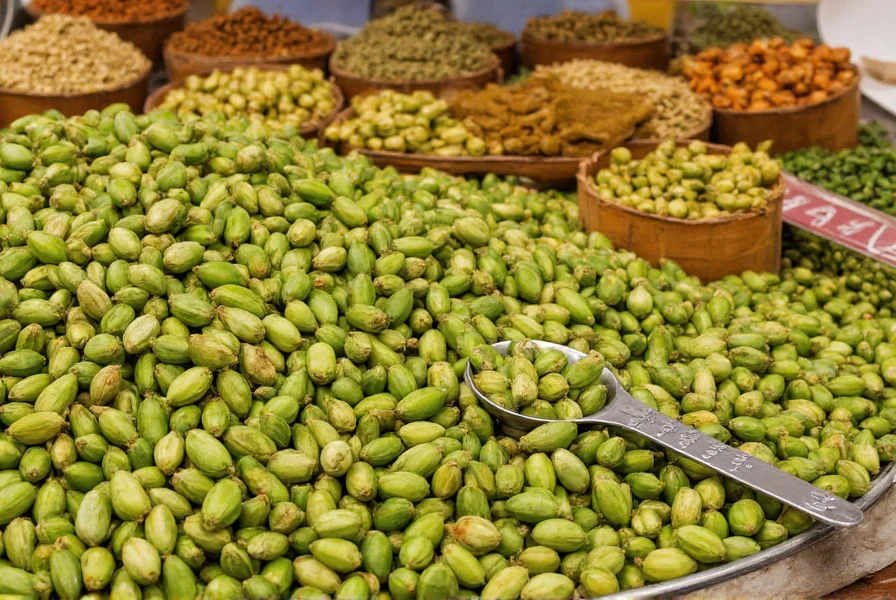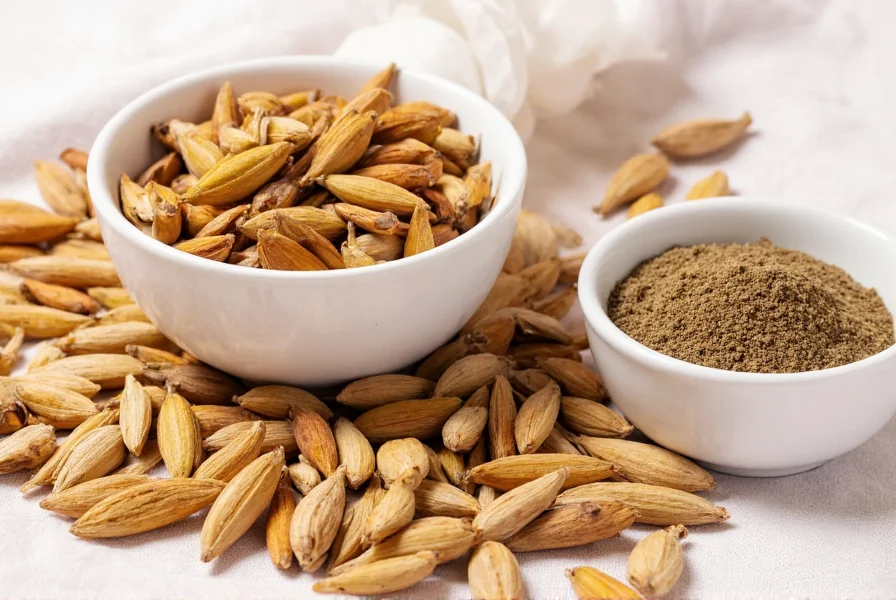Cardamom stands among the world's most valuable spices by weight, trailing only saffron and vanilla. Its distinctive flavor profile makes it irreplaceable in many traditional dishes and beverages. Understanding this spice's nuances helps home cooks and professional chefs alike unlock its full potential in diverse culinary applications.
Green Cardamom vs Black Cardamom: Key Differences
While both belong to the same botanical family, green and black cardamom serve distinctly different culinary purposes. Green cardamom pods feature a triangular shape with pale green coloration and deliver a bright, citrusy aroma with hints of mint and eucalyptus. Black cardamom pods appear larger, darker, and feature a rougher exterior with a noticeably smoky character developed during traditional drying over open flames.
| Characteristic | Green Cardamom | Black Cardamom |
|---|---|---|
| Botanical Name | Elettaria cardamomum | Amomum subulatum |
| Flavor Profile | Sweet, floral, citrusy with mint notes | Smoky, camphorous, earthy |
| Primary Culinary Use | Baking, desserts, chai, rice dishes | Meat stews, lentil dishes, spice blends |
| Preparation Method | Use whole pods or freshly ground seeds | Typically used whole, removed before serving |
| Storage Life (whole) | 9-12 months | 6-8 months |
Culinary Applications Across Global Cuisines
Cardamom's versatility shines through its integration into diverse culinary traditions worldwide. In Scandinavian baking, green cardamom features prominently in sweet breads like Swedish kardemummabullar and Finnish pulla. Indian cuisine utilizes both varieties—green in biryanis and desserts, black in savory meat dishes and certain curry blends. Middle Eastern coffee traditions often include crushed cardamom pods for aromatic enhancement.
When using cardamom in baking, always crush the seeds just before incorporation to maximize flavor release. The papery pods themselves contain minimal flavor, so focus on the tiny black seeds inside. For best results in Scandinavian cardamom buns, use freshly ground seeds rather than pre-ground spice to capture the full aromatic complexity.
Health Benefits Supported by Research
Beyond its culinary value, cardamom offers several potential health benefits. Studies indicate cardamom contains potent antioxidants that may help reduce oxidative stress. Research published in the Indian Journal of Pharmacology suggests cardamom may support oral health by inhibiting bacterial growth responsible for bad breath.
Traditional Ayurvedic medicine has long utilized cardamom for digestive support. Modern research partially validates this use, with some studies showing cardamom may help relax gastrointestinal muscles. However, those seeking cardamom spice health benefits should consume it as part of a balanced diet rather than relying on it as a primary treatment for medical conditions.
Proper Storage Techniques for Maximum Freshness
Preserving cardamom's delicate flavor requires careful storage. Whole green cardamom pods maintain quality for 9-12 months when stored in airtight containers away from light and heat. Black cardamom, with its more robust flavor, lasts slightly less time—6-8 months under similar conditions. Never store cardamom in the refrigerator, as moisture accelerates flavor degradation.
For those wondering how to store cardamom pods properly, follow these steps:
- Keep pods in their original protective husks until ready to use
- Transfer to an opaque, airtight glass container
- Store in a cool, dark cupboard away from the stove
- Check periodically for moisture or mold development
Substituting Cardamom in Recipes
When facing an empty spice jar, understanding appropriate cardamom substitutes in recipes becomes essential. No single spice perfectly replicates cardamom's complex profile, but combinations can approximate its character:
- For sweet applications: Equal parts cinnamon and ginger with a pinch of nutmeg
- For savory dishes: Coriander seed with a touch of cumin and allspice
- In Scandinavian baking: Cardamom extract (1/4 teaspoon replaces 1 pod)
When substituting, remember that cardamom's unique citrus-pine notes prove difficult to replicate exactly. The substitution ratio typically requires 1.5 times more substitute blend than the recipe specifies for cardamom.
Measurement Conversions and Usage Tips
Understanding cardamom measurement conversion prevents recipe failures. One green cardamom pod contains approximately 10-12 seeds, yielding about 1/8 teaspoon of ground spice. When a recipe calls for "crushed cardamom," this typically means lightly cracking the pods to release flavor while keeping them intact.
Chefs preparing the best cardamom for chai tea traditionally use 2-3 whole green pods per serving, lightly crushed before adding to the brewing mixture. The pods should steep with the tea but be removed before serving, as prolonged exposure creates bitterness. For stronger flavor, split the pods open before crushing.

Buying Quality Cardamom: What to Look For
Selecting premium cardamom requires attention to several factors. High-quality green cardamom pods feel heavy for their size with tightly closed seams. When squeezed gently, they should release a strong, sweet aroma. Avoid pods with visible cracks or excessive browning, which indicates age or improper drying.
For those exploring what does cardamom taste like, perform a simple test: crack open a pod and chew one seed. Premium cardamom delivers an immediate burst of citrus flavor followed by warm, herbal notes with a clean finish. Lower quality product may taste dusty or one-dimensional. Always purchase from reputable spice merchants who can verify harvest dates, as cardamom's flavor degrades significantly after six months.

Frequently Asked Questions About Cardamom
Can I use ground cardamom instead of whole pods?
Yes, but with flavor compromises. Substitute 1/8 teaspoon ground cardamom for each pod. However, whole pods provide superior flavor complexity and longevity. For best results in baking recipes, grind your own seeds from whole pods immediately before use rather than relying on pre-ground spice.
Why is my cardamom bitter?
Bitterness typically results from overuse, prolonged cooking, or using stale spice. Cardamom should enhance rather than dominate dishes. Limit to 3-4 pods per serving in savory dishes. In baking, use no more than 1/2 teaspoon ground cardamom per cup of flour. Always remove whole pods before serving cooked dishes.
Is cardamom safe for daily consumption?
Yes, culinary amounts of cardamom are generally safe for daily consumption. Most people safely consume 1-3 pods daily. However, extremely high doses (more than 10 pods daily) may cause digestive upset in sensitive individuals. Those with gallstones should consult a physician before consuming large amounts, as cardamom may stimulate bile production.
How can I tell if my cardamom has gone bad?
Stale cardamom loses its vibrant aroma and flavor. Perform the pinch test: crush a seed between your fingers. Fresh cardamom releases immediate, strong citrus fragrance. If the aroma seems dusty or barely noticeable, the spice has degraded. Properly stored whole pods maintain quality for 9-12 months, while ground cardamom lasts only 3-6 months.
Can I grow cardamom at home?
Growing cardamom requires tropical conditions (USDA zones 10-12) with high humidity, partial shade, and well-draining soil. It takes 2-3 years from planting to first harvest. Most home growers outside tropical regions find it impractical to cultivate cardamom successfully. Container gardening indoors proves challenging due to the plant's specific humidity and temperature requirements.











 浙公网安备
33010002000092号
浙公网安备
33010002000092号 浙B2-20120091-4
浙B2-20120091-4